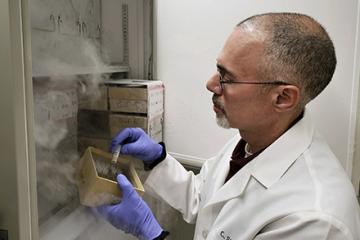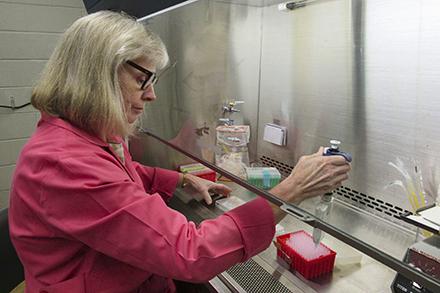Bacteria Turn Table Sugar into More

At ARS’s National Center for Agricultural Utilization Research in Peoria, Illinois, microbiologist Chris Skory locates a vial of Leuconostoc bacteria from a collection of frozen isolates. (Kristina Glenzinski, D4038-1)
Bacteria sometimes get a bad rap. But there are some good ones that deserve credit for making our lives better—and even keeping us healthy, too.
On the food-processing front, for example, are species of lactic acid bacteria that give sour pickles their unique, tangy taste—as well as yogurt, some cheeses, sauerkraut, and kimchi.
Now, Agricultural Research Service (ARS) scientists in Peoria, Illinois, have a new job for these helpful bacteria: turning sucrose (table sugar) into a sugar called isomelezitose. This specialty sugar has cell-protective abilities that could help prolong the shelf life of foods, drugs, vaccines, and even friendly bacteria and fungi used to fight crop pests.
Microbiologist Chris Skory and his colleagues are investigating the possibility at ARS’s National Center for Agricultural Utilization Research (NCAUR) in Peoria, where scientists develop new, value-added uses for agricultural commodities, surpluses, and byproducts. In this case, isomelezitose could open new market opportunities for sugarcane and sugar beet crops, including the $2-plus billion food preservatives world market.
NCAUR also houses one of the world’s largest collections of fungi and bacteria, including the Leuconostoc bacterial species the researchers used for their studies. They were using an enzyme called glucansucrase, made by the bacteria, to produce a useful new polymer, glucan, from sucrose. In an effort to improve production of this polymer, they modified the gene that produces the glucansucrase enzyme.
But the research took an unexpected turn.
Instead of producing the glucan polymer, this retooled version of the enzyme converted more than 60 percent of sucrose into isomelezitose—the highest yield achieved to date, the researchers learned.

Chemical engineer Pat Slininger adds a specialty sugar called isomelezitose to bacteria to test the sugar’s cell-protecting properties. (Chris Skory, D4039-1)
The implications of the finding were exciting, given isomelezitose’s predicted ability to protect cells from damage by extremes of heat, dryness, and cold.
"We discovered it serendipitously," says Skory, who is in NCAUR’s Renewable Technology Research Unit. He published a paper on the work in the journal Amylase together with ARS coauthors Chris Dunlap and Karl Vermillion, and Greg Cote, who recently retired from ARS.
In nature, isomelezitose can be found in trace amounts in honey and some other foods. Earlier attempts by others to synthesize it failed to exceed yields of 20 percent, but the ARS method, using cane and beet sugars, achieved yields of almost three times that. Encouraged by these results, ARS applied for a patent.
The researchers, together with Patricia Slininger in NCAUR’s Bioenergy Research Unit, have conducted some small-scale trials to examine the cell-protecting properties of isomelezitose to safely dry bacteria used for biological control applications.
"We found that isomelezitose increased cell viability after drying, and it extended dry storage of the bacteria by up to 1,000 times," says Slininger. "Depending on the bacterial strain, the level of cell protection by isomelezitose was at least equivalent to, but often greater than, that of other sugars known to have protein- and membrane-protective qualities."
The team’s focus now is to produce large batches of isomelezitose. "That way, industry can start comparing it to other sugars in its class," Skory says. — By Jan Suszkiw, ARS Office of Communications.

